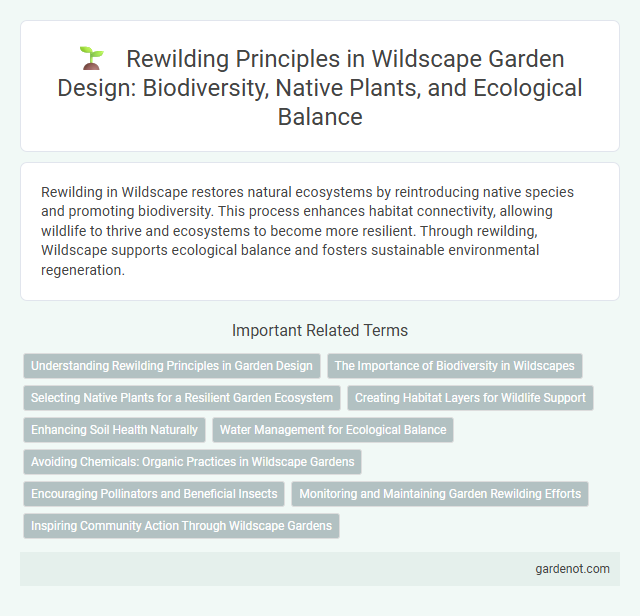Rewilding in Wildscape restores natural ecosystems by reintroducing native species and promoting biodiversity. This process enhances habitat connectivity, allowing wildlife to thrive and ecosystems to become more resilient. Through rewilding, Wildscape supports ecological balance and fosters sustainable environmental regeneration.
Understanding Rewilding Principles in Garden Design
Rewilding principles in garden design emphasize restoring natural ecosystems by prioritizing native plants, wildlife habitats, and ecological processes. Incorporating features such as diverse plant species, water sources, and shelter promotes biodiversity and resilience in urban and suburban environments. Understanding these principles enables gardeners to create sustainable, self-regulating landscapes that support local fauna and improve environmental health.
The Importance of Biodiversity in Wildscapes
Biodiversity is crucial in wildscapes as it supports ecosystem resilience, enabling habitats to recover from disturbances and adapt to environmental changes. Diverse species interactions maintain ecological balance, ensuring the survival of key flora and fauna essential for rewilding success. Healthy biodiversity enhances ecosystem services such as pollination, soil fertility, and water purification, which are vital for sustaining wildland restoration efforts.
Selecting Native Plants for a Resilient Garden Ecosystem
Selecting native plants such as coneflowers, milkweed, and black-eyed Susans supports a resilient garden ecosystem by promoting local pollinators and wildlife. These species are adapted to regional soil and climate conditions, reducing maintenance and water requirements while enhancing biodiversity. Incorporating diverse native flora creates habitat complexity essential for sustaining a balanced and thriving wildscape.
Creating Habitat Layers for Wildlife Support
Creating diverse habitat layers within wildscapes enhances ecological complexity, promoting shelter, food availability, and breeding sites critical for wildlife support. Integrating canopy trees, understory shrubs, and ground vegetation forms vertical stratification that sustains a variety of species, from birds to small mammals and insects. This structured habitat design accelerates rewilding success by fostering biodiversity and ecosystem resilience.
Enhancing Soil Health Naturally
Rewilding initiatives prioritize enhancing soil health naturally by restoring native vegetation and promoting biodiversity to improve soil structure and nutrient cycling. Integrating organic matter through native plant roots and decomposition processes increases microbial activity, fostering a resilient soil ecosystem. These methods reduce erosion, boost water retention, and create sustainable habitats essential for long-term ecological balance in wildscapes.
Water Management for Ecological Balance
Effective water management in Wildscape rewilding projects enhances habitat restoration and supports biodiversity by maintaining natural hydrological processes. Restoring wetlands, rivers, and floodplains promotes water filtration, nutrient cycling, and provides critical habitats for aquatic and terrestrial species. Implementing sustainable water flow regimes helps mitigate flooding risks and ensures a balanced ecosystem in rewilded landscapes.
Avoiding Chemicals: Organic Practices in Wildscape Gardens
Wildscape gardens prioritize organic practices by avoiding synthetic chemicals to promote biodiversity and soil health, essential for successful rewilding. Utilizing natural compost, mulch, and biological pest controls supports native plants and wildlife, enhancing ecosystem resilience. This chemical-free approach fosters habitats where pollinators, birds, and beneficial insects thrive, contributing to sustainable rewilding efforts.
Encouraging Pollinators and Beneficial Insects
Rewilding initiatives in Wildscape prioritize creating diverse habitats that support the thriving populations of pollinators and beneficial insects essential for ecosystem health. Native flowering plants, diverse nectar sources, and undisturbed nesting areas provide critical resources that enhance pollination and natural pest control. These efforts significantly increase biodiversity, improve soil fertility, and sustain healthy food webs.
Monitoring and Maintaining Garden Rewilding Efforts
Effective monitoring of garden rewilding efforts involves regular assessment of biodiversity indicators such as native plant growth and wildlife presence, enabling precise adjustments to habitat management practices. Utilizing tools like camera traps, soil health tests, and species surveys helps maintain ecological balance and track progress over time. Continuous maintenance, including selective pruning and invasive species control, ensures the sustainability of rewilded garden ecosystems and promotes natural regeneration.
Inspiring Community Action Through Wildscape Gardens
Wildscape gardens serve as dynamic examples of rewilding, encouraging urban and suburban communities to restore native habitats and biodiversity. These accessible green spaces demonstrate practical ways to support pollinators, wildlife habitats, and ecological balance within local environments. Engaging community members in creating and maintaining wildscape gardens fosters environmental stewardship and collective action toward sustainable ecosystems.
Rewilding Infographic

 gardenot.com
gardenot.com